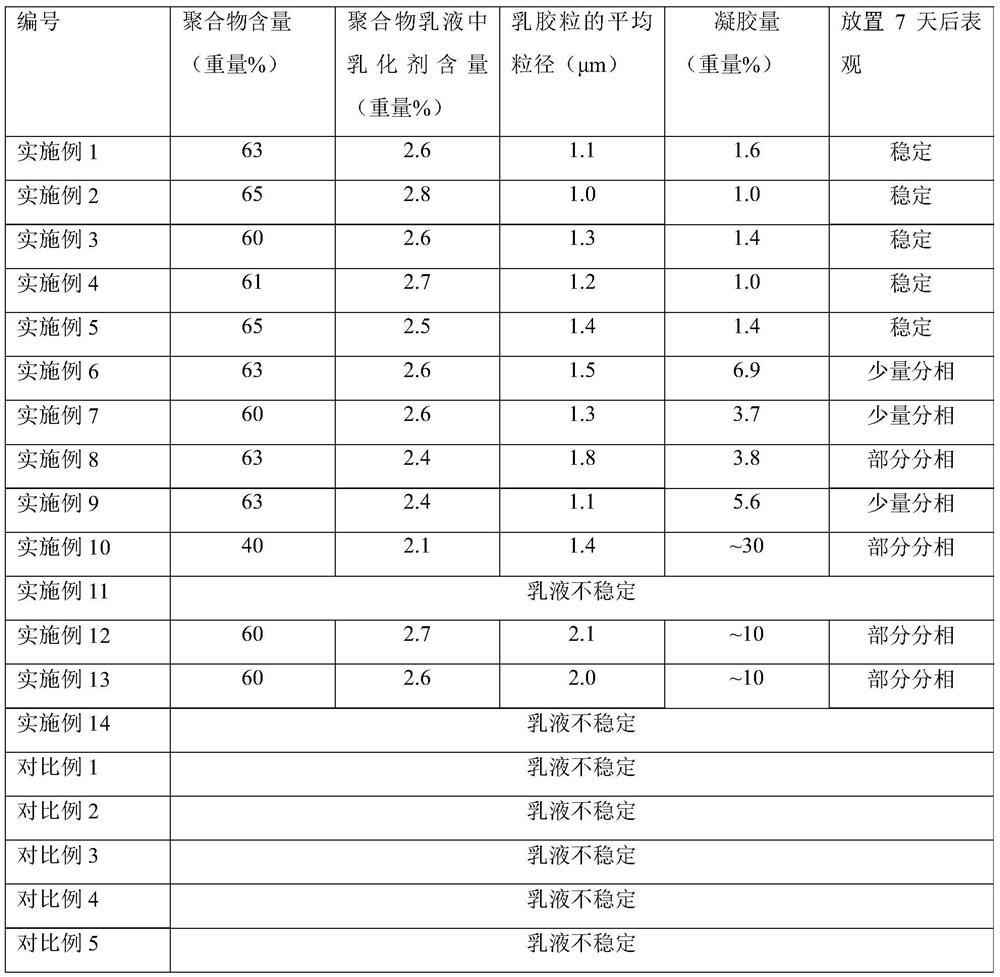Polymer emulsion and preparation method thereof
A polymer emulsion and polymer solution technology, applied in the field of polymer emulsion, can solve the problems of poor product stability and emulsification effect, achieve excellent performance, avoid demulsification, and avoid adverse effects
- Summary
- Abstract
- Description
- Claims
- Application Information
AI Technical Summary
Problems solved by technology
Method used
Image
Examples
preparation example Construction
[0016] According to a first aspect of the present invention, the present invention provides a method for preparing a polymer emulsion, the method comprising an emulsification step and at least one emulsion separation step,
[0017] In the emulsification step, the polymer solution containing the polymer and the organic solvent is mixed with the aqueous solution containing the emulsifier, and the obtained mixed solution is emulsified to obtain an emulsion;
[0018] The step of separating and concentrating the emulsion includes successive organic solvent removal sub-steps and centrifugation sub-steps. In the organic solvent removal sub-step, the emulsion is subjected to at least one distillation to remove part of the organic solvent in the emulsion. solvent to obtain a dilute emulsion, and in the centrifugal separation sub-step, the dilute emulsion is subjected to at least one centrifugation;
[0019] The emulsifier is an anionic emulsifier, and the polymer is a polymer formed by...
preparation example 1
[0098] In this preparation example, all reagents and reactors were used after anhydrous and oxygen-free treatment.
[0099] Mix 3.6mL of neodecanoate n-hexane solution with a concentration of 0.5mol / L, 43mL of triisobutylaluminum n-hexane solution with a concentration of 0.5mol / L, and 11mL of diethylaluminum chloride with a concentration of 0.5mol / L in n-hexane Alkane solution and 242mL of n-hexane were mixed to prepare a catalyst solution C1 with a concentration of 6mmol / l for later use. Isoprene solution polymerization was performed using the prepared catalyst solution C1. Under the protection of nitrogen, 5.2 mol of isoprene (IP), n-hexane and catalyst solution C1 were successively added to the reactor, and the catalyst dosage was 0.12 mmol Nd / mol IP. After reacting at 30° C. for 40 minutes, a methanol solution of 2,6-di-tert-butylhydroquinone was added to terminate the reaction. A glue solution Y1 with a concentration of 16 wt% was obtained.
[0100] After measurement, ...
preparation example 2
[0102] Under nitrogen protection, 10mol isoprene, 8.2L n-hexane and 5.3mL butyllithium n-hexane solution with a concentration of 0.1mol / L were successively added to the reactor, and the molar ratio of butyllithium to isoprene was 5.3×10 -5 . After reacting at 40° C. for 70 minutes, the reaction was terminated. A glue solution Y2 with a concentration of 11 wt% was obtained.
[0103] After measurement, the cis 1,4-structure content of polyisoprene is 81% by weight, the weight average molecular weight is 1.3 million, and the molecular weight distribution is 1.3. The apparent viscosity of the diene solution is 16800cP.
PUM
| Property | Measurement | Unit |
|---|---|---|
| particle size | aaaaa | aaaaa |
| particle diameter | aaaaa | aaaaa |
Abstract
Description
Claims
Application Information
 Login to View More
Login to View More - R&D
- Intellectual Property
- Life Sciences
- Materials
- Tech Scout
- Unparalleled Data Quality
- Higher Quality Content
- 60% Fewer Hallucinations
Browse by: Latest US Patents, China's latest patents, Technical Efficacy Thesaurus, Application Domain, Technology Topic, Popular Technical Reports.
© 2025 PatSnap. All rights reserved.Legal|Privacy policy|Modern Slavery Act Transparency Statement|Sitemap|About US| Contact US: help@patsnap.com


